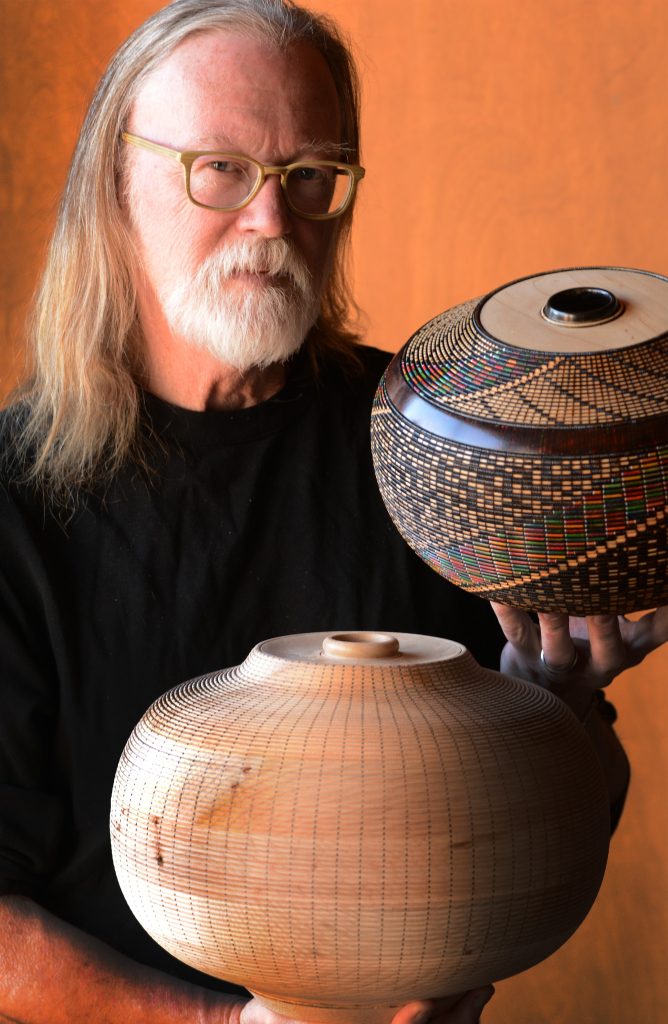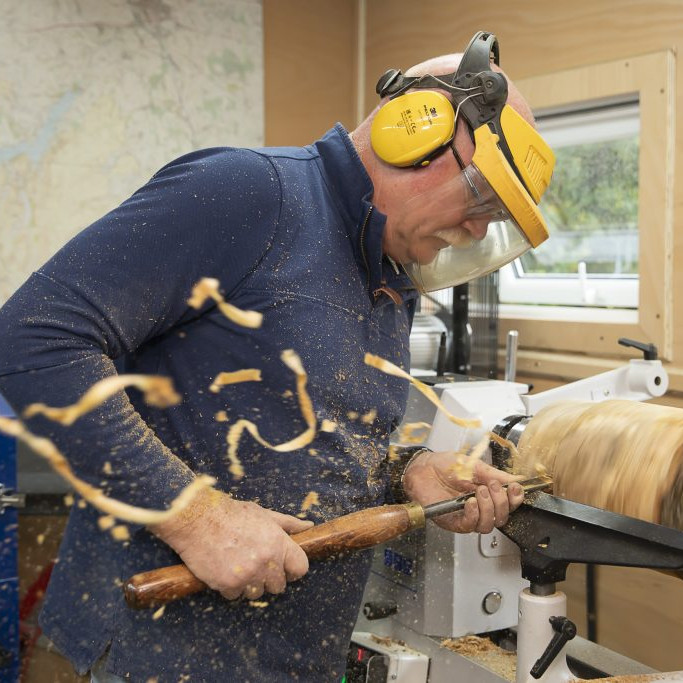Keoni Carlson Wood Artist
Your work is an illusion. Discuss
Illusion work involves using one medium/material to look like another. In my case, I use wood to represent the “illusion” of fabric and/or beadwork.

Copper Mountain, 8″h x 9″d vessel, Sugar Maple, woodburning, india inks, organic dyes and metallic inks
What have been some of the comments made by viewers when they realise it is wood?
There are very common reactions:
- . it’s really wood… didn’t believe it
- It must take an immense amount of time (yes, it does)
- I thought it was woven basketry
- Never saw the technique before
- How is it done?
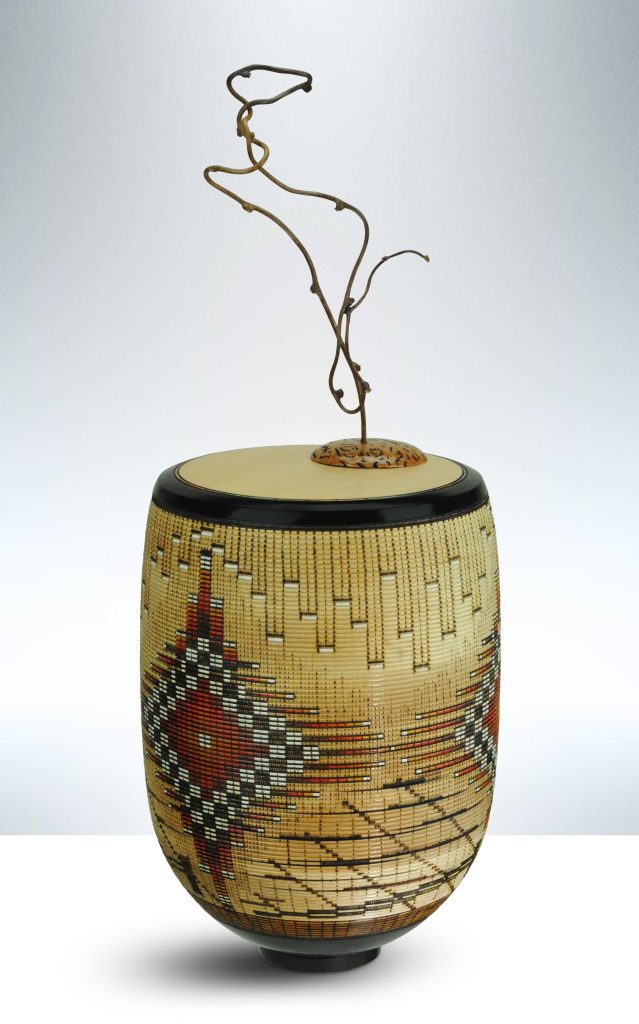 Sky Dreamer, 28″h x 9″d tabletop sculpture, Sugar maple, kiwi vine, red mallee burl, woodburning, india inks
Sky Dreamer, 28″h x 9″d tabletop sculpture, Sugar maple, kiwi vine, red mallee burl, woodburning, india inks
You have only been working on this technique since 2017. Where did the inspiration come from?
The practice of illusion carving is quite old: think Europe and the great Cathedrals where wood was carved and gilded to suggest stone; and then in China and Japan even earlier where stone was carved to mimic wood. Artists of respective regions using available, local materials to create the illusion of more scarce sources.
I saw the techniques demonstrated in the early 1990s then revisited the style in 2003/2004, particularly influenced by the work of Lincoln Seitzman and Jim Adkins and then later by artist David Nitman. With my retirement in 2017, I was able to begin exploring the technique in ernest.
My love for the Lathe began as a young boy when introduced to the tool by my father; I was a hobby woodturner from that time forward. The journey to professional artist was accidental and organic, the evolution paced by unexpected opportunities and encouragements from family, colleagues and patrons.
 Preparing the canvases
Preparing the canvases
You are a 3rd generation wood carver. What do you think your forebears would have to say of your art?
My hope is that they would be proud that the tradition of working with wood has continued. My family’s backgrounds were more as builders and carpenters… and the very practical world of the Mid-West and West, that I have found a niche as a wood artist would have both surprised and satisfied.
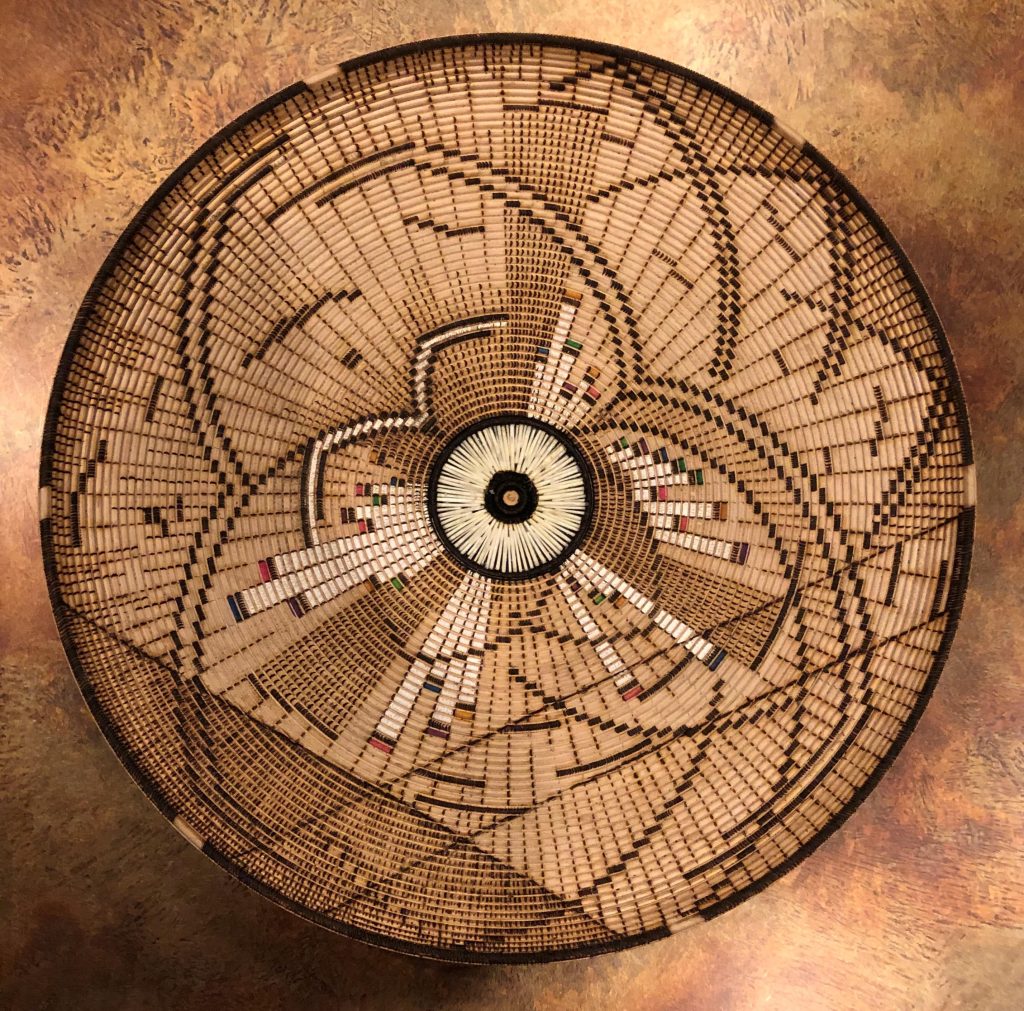
Contemporary wall sculpture, 22″d; “Eagles”. porcupine quill center.
Can you tell us where some of the very best woven baskets can be seen and in which museums or galleries?
“Best” is so subjective. Examples of the technique can be found in collections at The Smithsonian Museum and western art collections of museums such as The CM Russell, the Briscoe and the Eitlejorge, all in the US. Collectors range the world stage as do galleries that showcase Southwest/Western fine craft/fine art.
I’m honored to have been selected as a 2020 Smithsonian artist and will join 120 others next April in an exhibition and public sales event in Washington DC.
Discuss the importance of keeping American Southwest tribal culture alive through your art.
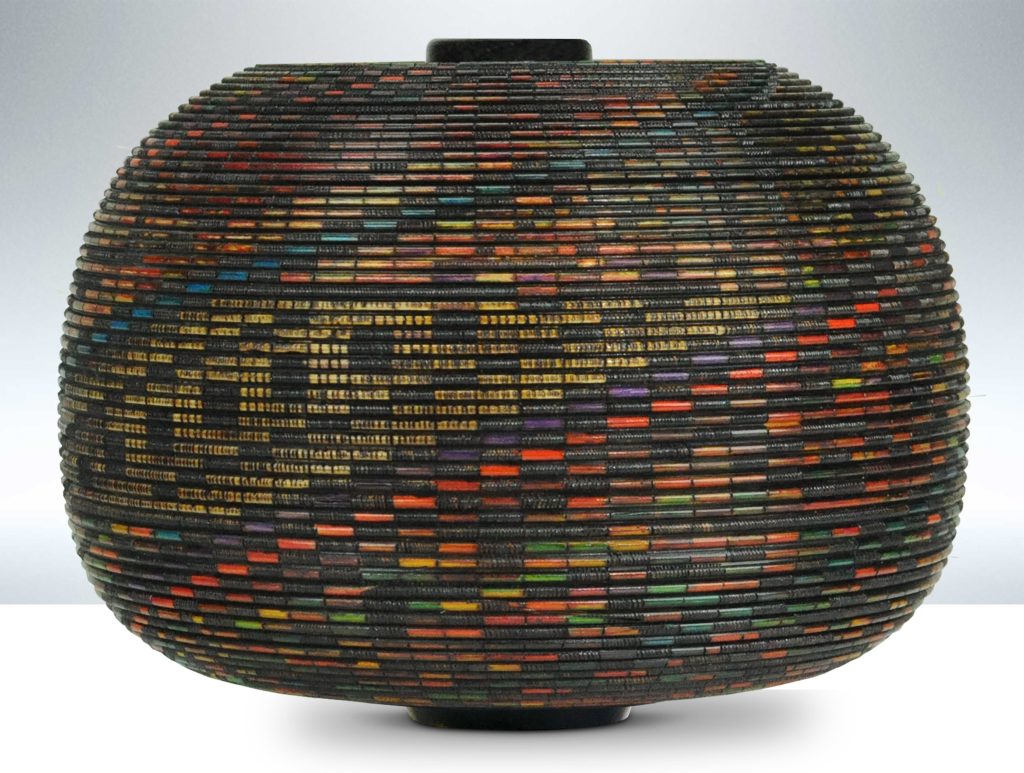
Joseph’s Coat: 8″h x 9″d vessel, Sugar maple, woodburning, india inks
My artwork is story-driven, an approach that I believe adds meaning and context beyond the wood art itself. I spend considerable time researching Native Cultures’ storytelling, legends and iconography. This provides a foundation for my eventual contemporary design interpretation.
Do you provide, an explanation of the story related to each piece?
Yes, of course… for any of the larger/major pieces. The story informs the piece and adds depth and meaning. I want to be sure my customers are able to tell their friends about the story of the artwork.
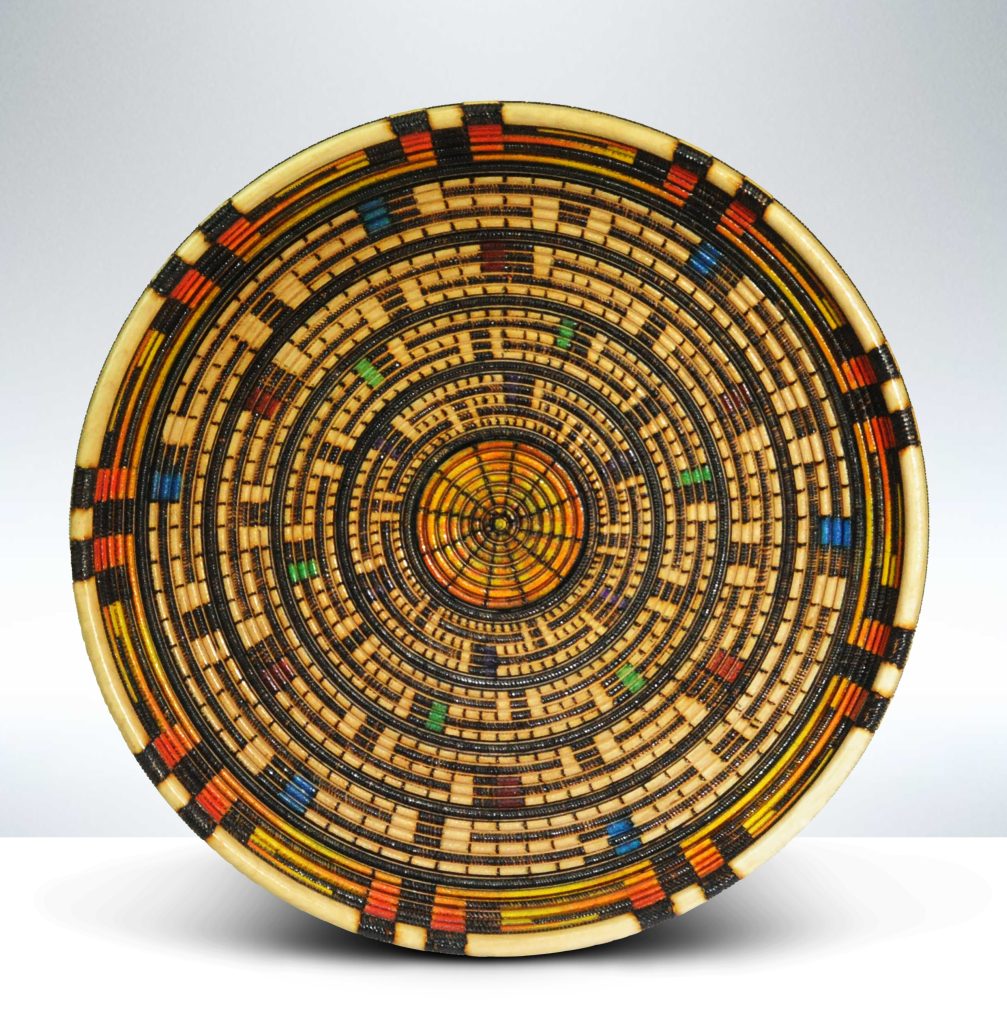 Sol Via, 15″d x 2″ wall sculpture, Sugar maple, woodburning, india inks
Sol Via, 15″d x 2″ wall sculpture, Sugar maple, woodburning, india inks
Comment on the marriage, of the two aspects of your work. Traditional wood carving and storytelling.
My work is story-driven… at least for the major and larger pieces. (small ones are just pretty (grin). I believe that the aspect of “story” adds much to the production of each illusion carving. “Story” is one of the things that sets my work apart. While patrons are drawn to the beauty and uniqueness, it is often the story of a piece that results in selection and purchase.

Sonoran Triplet: Dawn, Midday & Dusk, each platter is 10″d x 2″h, Sugar maple, woodburning, india inks
I do detailed research (thank you Internet) on tribal/Native Culture stories, legends, iconography and mythology. I have a degree in Library Science so am experienced in the process of detailed research; as well, my degree and earlier profession as a journalist also fostered my love of story… a grounding my entire life.
There’s an emotion to story that compliments the artwork
Once I’ve identified a story or aspect, then I interprete it into imagery that I can carve and color. All this is done freehand when sometimes a small bit of sketching. I don’t do detailed patterns or drawings prior to starting to carve. The spontaneous, organic nature of the interplay of carving and wood provide a one-of-a-kind direction.
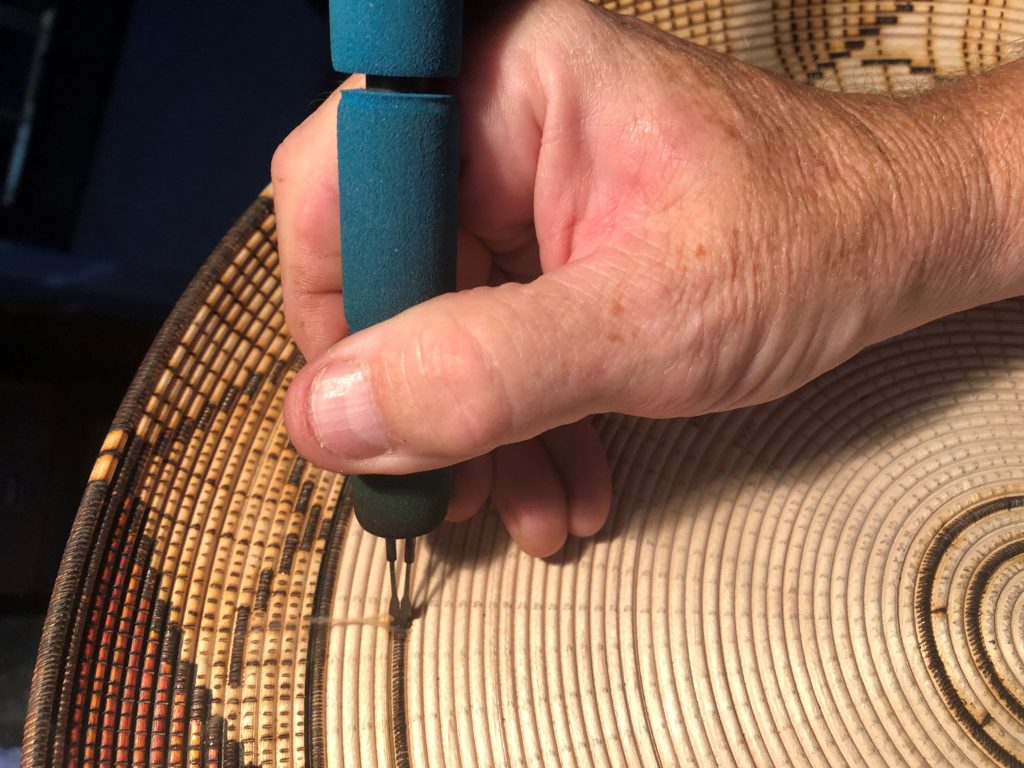
Detail shot: burning the design
What has led you to use sugar maple? Sugar maple is used for a very specific reason. Because I woodburn the designs at a very high temperature… the combination of heat + the sugar content of the wood itself produces a wonderful patina of soft browns and ivory as the cell structure actually carmelises.
You also use reclaimed or re-purposed maple. How difficult is it to source?
In the American late 1940s/1950s, furniture manufacturers used hardwoods such as Maple, Cherry and Oak to produce large volumes of functional furniture. Over the years, much of the work was handed down and eventually has found its way to flea markets, 2nd hand stores, etc. I look for these damaged, well-worn pieces and salvage wood. Another source is rail car flooring. Hardwood planks were inexpensive to use and the American rail industry expanded. Now many of the old freight boxcars are being scrapped and flooring recycled.
Patterns are represented using colour of the weave or beads that would have been woven into the baskets. Briefly can you explain how you do both techniques.
The woven technique involves woodburning a very high number of cuts in very fine-line detail. All the woodburning is done with a single tool… a 1/8” radius. By varying the pressure, the temperature and the density of strokes, I can create the illusion of weaving and fabric… even when looked at closely. From any distance, it’s difficult to believe “…it’s wood..”; For the woven designs that require color, semi-transparent India inks are applied. The transparency mimics the appearance of colored fabric. Inks are applied with brushes and solvent washes.
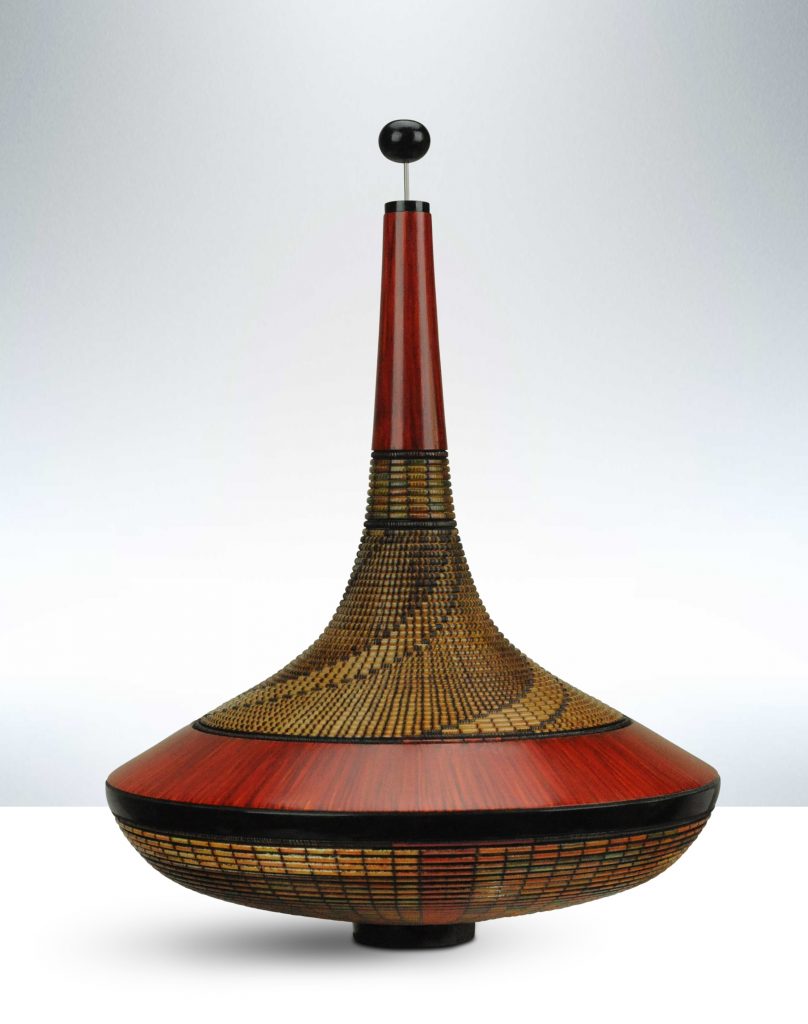
Ohana (family in Hawaiian) 14″H x 9″d vessel, Sugar Maple, woodburning, India inks
The beaded technique is again woodburned using the 1/8” tool. Actual beads are opaque in color. To achieve this, I use organic, solid dyes rather than the transparent inks. These dyes are actually applied twice. The first application of color soaks into the wood to produce a muted color effect. Can be nice but beadwork is opaque so a 2nd color coat needs applied. Each cell is colored discretely so that color does not bleed from cell to cell.
Can you expand on the inside of your baskets?
For some hollow-form executions, the vessel opening is large enough that the inside is visible. When this is the case, I woodburn and color the inside. This more than doubles the time required to finish the piece. As well, the entire inside must be finished first, then the outside of the piece is shaped to final form, carved and colored.
How do you sign your work?
I sign with my artist name: “Keoni”, the year a piece is produced, the name of the piece, and the studio location (either Colorado or California); On major pieces I also include a design reference number.
- I’ve became a professional artist (or at least started the journey in 2017 so have been at it for only three years at the professional level. Many fine this short time surprising.
- My success trajectory has been unexpected.
Year 1: Acceptance into a top tier art show; one gallery representation; several national awards.
Year 2: Full schedule of national, top tier art shows; nomination to the By Western Hands artisan guild; exhibition acceptance at The CM Russell Museum; multiple awards; additional gallery representation.
Year 3: Acceptance to the 2020 Smithsonian exhibition; SOFA-Chicago exhibition; refined, full schedule of top tier art shows; publicity coverage in several national publications ; refined gallery representation.
I believe my business background facilitated the fast start. Of course, the artwork had to be of commercial quality… but my understanding of the marketing, finance and business aspects was not a struggle… I’ve honed those skills with decades of a business career. I understood from the start, the need for branding… efficient material sourcing… differing customer sales channels… the value of publicity… tiered pricing… etc.
I often refer to myself as an “accidental artist…” as this current journey wasn’t at all planned. No art classes… no formal artist training…
I remain young and learning. Most every experience is a single data point, whether that be a gallery interaction… set-up and selling at a national show such as Philadelphia, Chicago or Smithsonian…
I am blessed many times over: my wife and life partner, Karen, is amazingly supportive; artist colleagues that freely share advice, experiences and hard-won knowledge… retail and gallery owners that, even in rejection, offer encouragement… and the many, many patrons that validate my work with each and every purchase.

Journey, wall sculpture, Leopard wood/stainless steel accent back: 24″h x 18″w Medallion: 13″d x 3″h
Contact:
Keoni
KeoniWoodArt.com
KeoniWoodArt@gmail.com
Deborah Blakeley, Melbourne, Australia
Interview by Deborah Blakeley, February 2020
Think a colleague or friend could benefit from this interview?
Knowledge is one of the biggest assets in any business. So why not forward this on to your friends and colleagues so they too can start taking advantage of the insightful information the artist has given?
Other artists you may be interested in:


